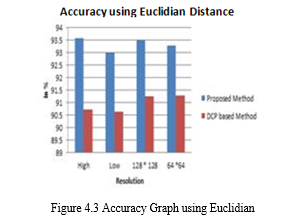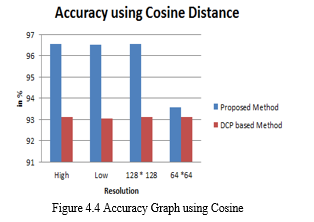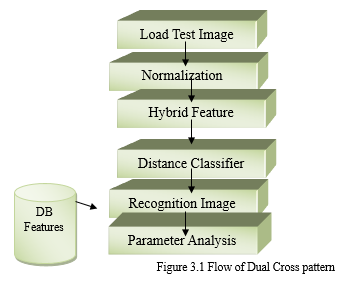Ijraset Journal For Research in Applied Science and Engineering Technology
- Home / Ijraset
- On This Page
- Abstract
- Introduction
- Conclusion
- References
- Copyright
An Adaptive Approach of Face Recognition for Low Intensity Images Using Texture Features
Authors: Abhishek Kumar, Ashish Chand
DOI Link: https://doi.org/10.22214/ijraset.2024.63085
Certificate: View Certificate
Abstract
Biometric recognition is the major field in the process of digitalization due to security. Face is an important biometric trait that can be used for security and authorization process. In this paper a novel approach has been proposed for face recognition process. Face recognition has major drawback of accuracy under low quality images that has improved in proposed approach. In this paper an approach of texture feature extraction has been hybrid with Dual cross pattern approach so that optimum set of feature can be computed. Experimental results have been extracted under variation in resolution. Proposed approach outperform to existing approaches.
Introduction
I. INTRODUCTION
A. Biometric
The field of Biometrics inspects just the physical or behavioural viewpoints that can be utilized to decide individual's personality. It is a programmed acknowledgment of a man in view of at least one of these highlights. "Biometrics" is likewise used to show biometric acknowledgment techniques. For instance, the face, fingerprints or the iris are some of the time perceived as one of kind biometric information. Afterward, Galton, Herschel, and Faulds saw the convenience of the edge designs show on our fingertips for recognizing a person. This prompted the improvement of unique mark coordinating frameworks. At first, the fingerprints were physically coordinated by the specialists however later, with the headway in figuring field, frameworks were produced to mechanize the handling (obtaining, coordinating and capacity) of fingerprints. Notwithstanding fingerprints, programmed handling of other individual qualities, for example, palm prints, confront, iris, and so on was likewise created in parallel.
B. Characteristics of Biometrics
Any physical and/or behaviour characteristics of a human can be considered as a biometric if it exhibits following characteristics:
- Universality: Each person accessing the biometric application should possess a valid biometric trait.
- Uniqueness: The given biometric trait should exhibit distinct features across individuals comprising the population.
- Permanence: The biometric characteristics should remain sufficient invariant over a period of time.
- Measurability: The biometric characteristics can be quantitatively measured i.e. acquiring and processing of biometric trait should not cause inconvenience to the individual.
- Performance: The biometric trait should the required accuracy imposed by the application.
C. Types of Biometrics
The biometric system can be classified into two different types:
1. Unimodal Biometric System
The unimodal biometric employs single biometric trait to identify the user Physiological biometrics identifiers include fingerprints, hand geometry, eye patterns, ear patterns, facial features, etc... Behavioral identifiers include voice, signature, typing patterns etc. While recognizing a person’s feature, there are chances for the system to decide a genuine person as an imposter or an imposter as a genuine.
Example: Biometric system based on Face or Palm prints or Voice or Gait etc.
2. Multimodal Biometric System
A multimodal biometric system combines two or more features of a person to be recognized together to determine a person’s authentication. Multi modal biometric systems can significantly improve the recognition performance in addition to improving population coverage, deterring spoof attacks, increasing the degrees of freedom, and reducing the failure-to-enrol rate. And also the storage requirements, processing time, and computational demands of a multimodal biometric system can be higher than that of the unimodal biometric system. Multimodal biometric frameworks use numerous sensors or biometrics to conquer the constraints of unimodal biometric frameworks. Case in point iris distinguish frameworks can be traded off by maturing iris and finger examining frameworks by exhausted or cut fingerprints
D. Biometric Modalities
- Gait
- Voice
- Hand Geometry
- Fingerprint
- Face
- Fingerprint
Fingerprints—the patterns of ridges and valleys on the “friction ridge” surfaces of fingers—have been used in forensic applications for over a century. Friction ridges are formed in utero during fatal development, and even identical twins do not have the same fingerprints. The recognition performance of currently available fingerprint-based recognition systems using prints from multiple fingers is quite good. One factor in recognition accuracy is whether a single print is used or whether multiple or ten prints (one from each finger) are used. Multiple prints provide additional information that can be valuable in very large scale systems. Challenges include the fact that large-scale fingerprint recognition systems are computationally intensive, particularly when trying to find a match among millions of references.
2. Iris
We are living in the age, in which the demand on security is increasing greatly. Consequently, biometric recognition, which is a safe, reliable and convenient technology for personal recognition, appears. Iris recognition is the procedure of perceiving an individual by dissecting the irregular example of the iris. A biometric system is a pattern recognition system including acquiring the biometric feature from individual, extracting the feature vector from the raw data and comparing this feature vector to another person’s feature vector. Fingerprint, palm-prints, face, iris, gait, speech and signature are widely used biometric feature. Biometric recognition can be used in computer network login, internet access, ATM, credit card, national ID card, driver’s license and so on. Nowadays, fingerprint recognition is used widely and successfully. Face recognition is studied by many scholars and experts. Iris recognition is a relatively new branch of biometric recognition. The human iris is the annular part between pupil and sclera. It has distinct feature such as freckles, coronas, stripes, furrows and so on.
3. Speech
Speech is a combination of both physical and behavioral biometrics traits. The features of an individual’s voice are based on the shape and size of the appendages (e.g., vocal tracts, mouth, nasal cavities, and lips) that are used in the synthesis of the sound. Physical characteristics of behavior part of speech change with the age, because of some medical conditions such as cold etc. A text-dependent voice recognition system is based on the utterance of a fixed predetermined phrase i.e. password. A text-independent voice recognition system recognizes the speaker independent of what she speaks. A text-independent system is more difficult to design than a text-dependent system but offers more protection against fraud. Speech recognition is most appropriate for phone-based applications but there are chances of degradation of speech signal due to quality of microphone and communication channel.
4. Face
Face is the important part of the human body that has been used for recognition process of the human being. Face is the main part that can be easily stored in the memory and having uniqueness in terms of shape and structure from all other individual. There is less chance that two humans being having identical faces even two twins have some properties that differentiate each other.
In the process of digital image process face plays vital role for human verification and identification process. The skill is quite robust, despite large changes in the visual stimulus due to viewing conditions, expression, aging, and distractions such as glasses or changes in hairstyle.
Computational models of faces have been an active area of research since late 1980s, for they can contribute not only to theoretical insights but also to practical applications, such as criminal identification, security systems, image and film processing, and human-computer interaction, etc. However, developing a computational model of face recognition is quite difficult, because faces are complex, multidimensional, and subject to change over time. Generally, there are three phases for face recognition, mainly face representation, face detection, and face identification.
II. REVIEW OF LITERATURE
Baohua Yuan, Honggen Cao, Jiuliang Chu (2013) “Combining Local Binary Pattern and Local Phase Quantization for Face Recognition” Purposed an approach for face recognition using the Local Binary pattern (LBP) and Local Phase Quantization (LPQ). In this paper the data from the picture spatial space and recurrence area has been recovered. This data is joined which can give the essential data about the picture that can't be given by the person of these highlights. The picture is isolated into a few locales and the LBP is connected to every area for extraction of the highlights of spatial space and LPQ is connected for the highlights accessible in the recurrence area. These component vectors are connected into one element vector and grimace descriptor. This descriptor is utilized for the acknowledgment procedure for the face. This test gives the best outcomes for the YALE and AR datasets.
Caixia Liu (2014) “The development trend of evaluating face-recognition technology” In practical application, the result of face recognition not only depends on the static face recognition algorithm, but also depends on the dynamic face recognition algorithm. In a face recognition system, face image acquisition equipment and algorithm processor hardware will also affect speed and effect of the recognition. Therefore, when evaluating face-recognition technology, we should not only carry out the static test of algorithm, but also carry out the dynamic face recognition test of actual faces. At the same time, considering the influence of hardware configuration, hardware configuration parameters of face recognition products or systems should be paid more attention. In the future, the development trend of evaluating face-recognition technology will become both static test in algorithm level and dynamic test of recognition effect to actual faces in application level should be carried out. Even the videotaped face-recognition test and system hardware configuration check should be carried out simultaneously.
Edy Winarno (2017) “Anti-cheating presence system based on 3WPCA-dual vision face recognition” To prevent counterfeit face image on face presence system, we can use dual vision camera in face recognition system. Dual vision camera is used to produce detectable face images from two positions of the left lens and the right lens. Image retrieval at the two corners of the left lens and the right lens can produce a merged face image database of left lens face image and right lens face image. The use of two sides of the face angle taking is used to avoid falsification of facial data such as the use of a face photo of a person or an image similar to a person's face. This research uses a dual-vision face recognition method on its preprocessing and uses 3WPCA (Three Level Wavelet Decomposition - Principal Component Analysis) as its feature extraction model. In dual-vision face recognition, we use half-join method to combine a half of the left image and a half of the right image into an image that is ready to be extracted using 3WPCA. This research can produce a presence system based on good face recognition and can be used to anticipate falsification of face data with recognition accuracy up to 98%.
Hyung-Il Kim ; Seung Ho Lee (2015) “Face image assessment learned with objective and relative face image qualities for improved face recognition” Considerable research efforts have been made for face recognition in various real-world applications. However, degraded face images, acquired in the real-world, make face recognition difficult. In this paper, we propose a new face image quality assessment that aims to realize a robust and reliable face recognition system. The proposed method considers two factors for face image quality, i.e., visual quality and mismatch between training and test face images. A face image quality assessor is learned based on the two factors to discriminate useful faces from unuseful ones. The proposed face image quality assessment model is robust and adaptive to face recognition systems by employing a learned assessment. Our experimental results on a challenging database show significant improvement in face recognition accuracy by the proposed method.
Momoko Hada ; Ryoko Yamada (2018) “How does the transformation of an avatar face giving a favourable impression affect human recognition of the face?” We investigated how different appearances in the favourable impressions of 3D avatar faces affect face-recognition performances by humans. We conducted an encoding and testing experiment using synthesized facial images and artificially manipulated the strength of the perceived impressions in three different dimensions.
We also subjectively assessed the favourability of the synthesized faces that were used as visual stimuli in face-recognition tests and found that facial transformation, which decreased the favourability impressions, generally deteriorates human face-recognition performance.
Yue ZENG, Dazheng FENG, Li XIONG (2011) “An Algorithm of Face Recognition Based on the Variation of 2DPCA”, Proposed a new approach for symmetry of face, the Characteristic of PCA and 2DPCA. The covariance lattice created utilizing 2DPCA is the mean of the PCA segments that registers corner to corner. This calculation in some cases dismisses the essential component data that has been valuable for acknowledgment. A calculation of face acknowledgment in light of the variety of 2DPCA (V2DPCA) is proposed which make the most helpful of the segregate data of covariance, and utilize the less coefficient to speaking to a picture. Tests on the ORL and YALE confront bases demonstrate change in both acknowledgment exactness and acknowledgment time over the first 2DPCA, and are likewise better than the conventional Eigen faces, ICA (Independent Component Analysis) and Kernel Eigen faces regarding the acknowledgment precision.
Jian Yang, YongXu and Jing yu Yang (2010) “Bi-2DPCA: A Fast Face Coding Method for Recognition”, proposed a calculation the works same as that of the 2DPCA in this strategy the coefficients are more than that of the PCA. So this leads the moderate grouping pace and expansive stockpiling necessities for huge scale database. In this calculation to defeat this issue the 2DPCA pressure is done double the first flat way and second one in the vertical course. By utilizing this approach order speed of the calculation increments and the capacity prerequisites diminishes for the extensive scale databases. During the time spent 2DPCA the Eigen esteems has been processed and covariance framework has been produced on the premise of Y=AU. This recipe diminished the network measurements of the 2 dimensional information that has been utilized as highlights for confront pictures. This approach diminishes the measurement on a level plane and stupor posture of cross result of C=transpose of X*Y packs the information in the vertical measurements. This lessens the element dimensional that expansion the execution of the calculation.
III. PROPOSED WORK
Face recognition is the process of matching an individual identity to the database images on the basis of facial features. In this process, face images have been acquired and used for extracting the features. In this process of facial recognition, different approaches have been widely used. The widely used facial recognition approaches are prone to laying, illuminating, and resolving images. This article has proposed an approach that has been used for facial recognition under different poses, illumination and low resolutions. In proposed work hybrid approach has been used for feature extraction from facial images. In this process texture features have been used in combined manner so that greater recognition accuracy can be obtained. To optimize best features in face recognition these features have been concatenated into single vector so that optimum feature subset for facial images has been developed.
On the basis of hybrid approach features from face images have been computed and stored in the database files. After this process test image features have been computed and used for recognition process based on distance classifier.
IV. RESULTS
This phase of the proposed work explains the results of the proposed work that has been done by using the hybrid approach of DCP and LBP. In this work the biometric system face recognition has been done on the basis of low resolution face images. The proposed work is done by using the feature extraction from the test image under different resolutions and variations. In this proposed work texture and structural features that are based on Eigen values have been computed so that better face representation can be achieved through feature extraction. On the basis of these approaches texture and facial features for face images have been computed and these features have been recombined in a single feature vector so that a single vector can represents better description about the face images.
In the process of face recognition and verification facial Image features have been extorted that has been used for recognition process on the basis of distance classifier with features to dataset images. Two different distance classifiers that are Euclidian distance classifier and cosine distance classifier. Classifier has been used for computation between the features of query face image to features of the dataset images features. Distance for the entire images available in the dataset has been computed with respect to query image features. Image that contain minimum difference based on features have been selected as the best matched image that is relevant to query image.
In proposed work performance evaluation parameters that are analyzed are recognition accuracy, EER (Equal Error Rate) and first one recognition rate. These parameters have been analyzed under different resolutions so that system can be easily validated for various resolution aspects. Low resolution images infer to low recognition accuracy that causes various issues in the process of surveillance as well as criminal identification. To overcome this issue in the proposed work a novel approach has been proposed that is based on texture and Eigen value based features. Equal error rate has been computed on the basis of false acceptance rate and false rejection rate. A system that comprises minimum false acceptance rate and high false rejection rate that type of biometric system has been validated for real world applications that are used for security purpose. On the basis of these parameters a system that provide better recognition accuracy, first one recognition rate and minimum equal error rate has been validated as optimum face recognition system. In proposed work performance evaluation parameters have been compared with dual cross pattern approach that is texture feature based approach that has provide low accuracy under low resolution images. The purposed system provides the more recognition rate and more accuracy than the existing based face recognition system.
A. Accuracy
Face recogniton acucracy is performance evaluation parameter that has been computed for validation of proposed system. Accuracy is computed on the basis of ratio of the total true macted images to total test image that has been used for face recogniton process. In the proposed work 160 images have been used as test images for face recogntion system. The images in the proposed work that has been used for testing are used under combination of DCP and PCA at different resolutions.
Accurarcy=[Matched Images/Total test images*100)]
B. Experimental results using Euclidian Distance classifier
On the basis of Euclidian distance classifier images has been used for recognition process. Euclidian distance is commonly used for distance computation between two vectors based on distance formulas.
Table 1 Face recognition accuracy using Euclidian classifier
|
Resolution |
Testing Images |
Proposed |
DCP |
|
High |
160 |
93.56 |
90.72 |
|
Low |
160 |
92.98 |
90.62 |
|
128 * 128 |
160 |
93.48 |
91.25 |
|
64 *64 |
160 |
93.26 |
91.26 |
Table 1 represents face recognition accuracy of the proposed model using different resolution samples for face recognition process.

Figure 4.3 represents accuracy of the proposed work based on Euclidian distance under different resolution of the images. This method outperforms under various low resolutions face images.
C. Experimental results using Cosine Distance classifier
On the basis of cosine distance classifier images has been used for recognition process. Cosine similarity has been used for computation of distance based on angles. This approach is independent to length of vectors
Table 2 Face recognition accuracy using Cosine classifier
|
Resolution |
Testing Images |
Proposed |
DCP |
|
High |
160 |
96.55 |
93.12 |
|
Low |
160 |
96.53 |
93.06 |
|
128 * 128 |
160 |
96.56 |
93.12 |
|
64 *64 |
160 |
93.57 |
93.13 |
Table 2 represents face recognition accuracy of the proposed model using different resolution samples for face recognition process.

Figure 4.4 represents accuracy of the proposed work based on Euclidian distance under different resolution of the images. This method outperforms under various low resolutions face images
Conclusion
In proposed work texture and eigenvalue based features have been used so that better accuracy can be achieved under pose variation as well as under low resolution samples. In the processing of face recognition distance classifiers have been used for matching of the query image to the dataset image based on features that have been extracted from the images. The combination of Dual cross pattern and principal component analysis has been used for the face recognition system with low resolution face images. Dual cross pattern is applied to face image for the extraction of features using different texture points. LBP has been used so that Eigen values based texture can be used as shape based features from face images. These features have been stored in a single feature vector that describe about information about different features from face image. These features have been used for matching process based on different distance classifiers so that best match can be evaluated from the dataset images. The comparative study includes the comparison proposed algorithm and Dual Cross pattern (DCP). In proposed work performance evaluation parameters have been analyzed so that validation of the proposed system can be done. Accuracy, first recognition rate, EER, has been analyzed in the proposed system. On the basis of these parameters one can conclude that proposed system provide better accuracy as compare to existing approach that is based on texture features.
References
[1] Baohua Yuan, Honggen Cao and Jiuliang Chu (2012), “Combining Local Binary Pattern and Local Phase Quantization for Face Recognition” International Symposium on Biometrics and Security Technologies, pp. 51-53, ISBN 978-1-4673-0917-2 [2] Caixia Liu “The development trend of evaluating face-recognition technology”, 2014 International Conference on Mechatronics and Control (ICMC), 3-5 July 2014. [3] Edy Winarno ; Wiwien Hadikurniawati “Anti-cheating presence system based on 3WPCA-dual vision face recognition”, 2017 4th International Conference on Electrical Engineering, Computer Science and Informatics (EECSI), 19-21 Sept. 2017. [4] Hyung-Il Kim ; Seung Ho Lee “Face image assessment learned with objective and relative face image qualities for improved face recognition”, 2015 IEEE International Conference on Image Processing (ICIP), 27-30 Sept. 2015. [5] Momoko Hada ; Ryoko Yamada “How does the transformation of an avatar face giving a favorable impression affect human recognition of the face?”, 2018 International Workshop on Advanced Image Technology (IWAIT), 7-9 Jan. 2018. [6] Yue ZENG, Dazheng FENG, Li XIONG (2011) “An Algorithm of Face Recognition Based on the Variation of 2DPCA, Journal of Computational Information Systems, vol. 7, issue 1, pp. 303-310 [7] Jian Yang, Zhang, D., Frangi, A.F. and Jing-Yu Yang (2004), “Two Dimensional PCA: A New Approach to Appearance base face representation and Recognition”, IEEE Transactions on Pattern Analysis and Machine Intelligence, Volume:26, Issue, 1, pp. 131-137, ISSN 0162-8828 [8] Pong C. Yuen, J.H. Lai (2002) “Face representation using independent component analysis”, in the journal of Elsevier B.V pattern recognition, vol. 35, issue 6, pp. 1247-1257, DOI 10.1016/S0031-3203(01)00101-7 [9] Rashid, R.D., Jassim, S.A. and Sellahewa, H. (2013) “LBP Based on Multi Wavelet Sub-Bands Feature Extraction Used for Face Recognition”, IEEE International Workshop on Machine Learning for Signal Processing, pp. 1-6, ISSN 1551-2541 [10] Samaria, Ferdinando and Harter, Andy (1994) “Parameterization of a Stochastic Model for Human Face Identification” IEEE Workshop on Applications of Computer Vision, Sarasota FL [11] Sena, Bima, Bayu D. and Miura, Jun (2013) “Fuzzy-Based Illumination Normalization for Face Recognition” IEEE Workshop on Advanced Robotics and its Social Impacts, Pp. 131-136, DOI 10.109/ARSO.2013.6705518
Copyright
Copyright © 2024 Abhishek Kumar, Ashish Chand. This is an open access article distributed under the Creative Commons Attribution License, which permits unrestricted use, distribution, and reproduction in any medium, provided the original work is properly cited.

Download Paper
Paper Id : IJRASET63085
Publish Date : 2024-06-03
ISSN : 2321-9653
Publisher Name : IJRASET
DOI Link : Click Here
 Submit Paper Online
Submit Paper Online


